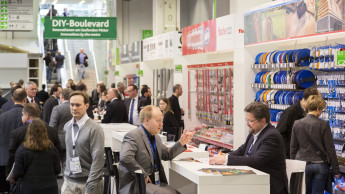Indianapolis, Indiana, and surrounding suburbs is one of the first metro markets in which the nation’s three largest home center chains are competing head to head – Home Depot, Lowe’s and privately-owned Menards.
Conventional industry wisdom says it takes 35-38,000 households to support a major big-box home center. With the three chains running 18 stores, the number of households-per-store is down to less than 24,000.
Though store sizes may be similar (100,000 sq. ft. each or larger) and the same types of products are being sold by each, in many other ways the 3 firms give consumers decidedly different choices:
Choices in store ambience – i.e., bare-bones warehouses to upgraded, better-lit warehouses to conventional gondola fixtures at Menards
Choices in in-store light levels – from Depot’s minimal lighting to Lowes brighter levels and Menards’ even brighter lighting
Color schemes – from Depot’s dominant orange to Lowes blue and Menard’s green and red
Choices in categories which are featured in store layouts
Choices in type and frequency of advertising
It is in this latter choice, however, that one can see the emerging strategies behind the competitive scene. The advertising reflects the direction in which the three chains appear to be headed.--nextpage--
Menards
These stores reflect less of the warehouse look than either Lowes or Depot because they utilize gondola fixtures in most areas of the store instead of warehouse racking, and it is the most aggressive local advertiser.
It features weekly circulars, generally containing 32 8” x 10” pages, which are item-oriented. Each circular contains some 350-500 priced items, including lumber and other building materials. Each ad has a theme. Contests are frequently a front-page feature – a great way to accumulate direct mail lists.
Menard also features seasonal opportunities regularly such as Halloween, and it often offers non-hardgoods items at special prices, such as candy bars.
Discounts and sale prices are prominently featured on each page and/or by each item. The emphasis constantly is on savings.
Regular weekly circulars are supported by TV spots in markets such as Indianapolis, these being institutional but always stressing Menards’ low prices and price-beating guarantee.
Lowe’s
Lowes’ consumer advertising reflects its upscale store design, compared to Home Depot. In other words, it is more colorful and stylish than that of either of the other two chains.
Printed by rotogravure, it is on a better grade of paper than Menards, features some large, image-building 4-color photographs and some large color illustrations of products. It also features several hundred items, with a considerable emphasis on bigger ticket items (power tools, powered lawn equipment, etc.).
Because it is America’s second largest retailer of major appliances, these products get far more attention in a typical Lowes circular than the space given to them in either Menards or Depot, both latecomers to selling these products. A recent Lowes 40-page circular also featured its installation services.
Another element of Lowes’ advertising is that it is filled with product knowledge and helpful homeowner tips. It is obvious the company is seeking to convey its helpful image in print as well as on the sales floor.
Lowes’ TV advertising stresses key categories like major appliances, shows its well lit, well-signed sales floor and emphasizes its physical attributes as well as its claim to superior customer service.
Home Depot
Surprisingly, Home Depot, as the newcomer to the market, has done less advertising in its first 6 months than either of the other two chains. While it does run circulars similar to those of Menards, it does so far less frequently – apparently about once a month, not weekly.
In early October, its weekly ad was an 8-page gravure piece, 9” x 12”, which was primarily devoted to flooring of all types, with the last page also featuring window blinds.
Like the Lowes circular, it featured full color photographs-- large illustrations. While it stressed price, it did so in a more subdued fashion than the Menard sales circular. It also mentioned that carpeting and flooring could be installed by Depot.
The look of the flooring circular is far more upscale than the look of the way products are displayed on Depot’s sales floor. It is quite a contrast between the ad look and the store itself.
Depot’s TV advertising is national, and emphasizes price and assortment, often showing store shots of warehouse racking.
Bob Vereen, USA











